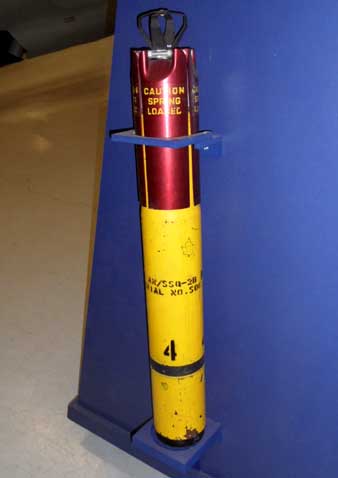PRINCIPLE OF OPERATON
Listening sonobuoy AN/SSQ-2 is expendable equipment used to detect underwater
sounds and transmit them by radio to nearby aircraft or to other stations
equipped with a suitable receiver. It is designed to be carried and launched
from naval aircraft, particularily from carrier and patrol aircraft and
dropped under the following conditions:
a) at a speed of not more than 150 knots when at a minimum altitude
of 150 feet or
b) at higher speeds up to 250 knots at a minimum altitude of 500 feet.
Upon being dropped from the aircraft, four blades on the cap of the
sonobuoy open and rotate to stabilize and slow its descent to the water.
Upon impact with the water, the rotating blade assembly is jettisoned,
the dye-marker tubes are broken and a red dye colours the surrounding water.
Next, the hydrophone is released and submerges to the end of its 40 foot
cable. The FM radio antenna is erected and sea water enters the A-battery
compartment. The sea water activates the A-battery and within a minute,
the equipment is in operation.
Underwater sounds detected by the hydrophone are amplified and frequency
modulate the transmitter. When signals from this transmitter are received
and demodulated in a suitable receiver, they provide a means of identifying
and locating the underwater sound source.
Location of the sonobuoy while in operation is revealed at close range
by the red dye-marker in daylight and by two incandescent lamps at night.
For locating the SSQ-2 at greater distances there is a beacon receiver
having an antenna which receives X and S band radar signals. The beacon
receiver triggers a blocking oscillator, which in turn, amplitude-modulates
the final stage of the transmitter. These reply signals can be detected
for approximately 15 miles on the S radar band or 10 miles on the
X band.
The unit incorporates an automatic scuttling device consisting of a
water soluble plug in the casing below the water line. When this plug dissolves,
the interior of the equipment is flooded, causing it to sink. The floating
period is a function of the water temperature, with the plug dissolving
more rapidly in warmer water. If recovery is desired, the plug can be covered
with tape before the equipment is launched.
 |
| This AN/SSQ-2B is on display at the Shearwater
Aviation Museum. (Photo by Ian Snow) |
In summary, the four wings were airfoil shaped and after launch would
open up and begin rotating. In effect an autogyro. On impact with
the water the base plate was driven upward about a quarter of an inch.
This initiated two actions. It pushed a metal rod, running the length of
the sonobuoy, upward. At the top the rod was bent into a J-hook which,
when pulled out of a circular retaining ring, released the rotorchute.
Two locking pins on the base plate were also retracted allowing the base
plate to fall away, releasing the hydrophone pack.
ELECTRICAL CHARACTERISTICS
Power Supply: Battery operated from a special dry B-battery and a sea
water activated A-battery. The B- battery supplies 150, 45, -3 and -15
volt outputs. The A-battery provides 1.2 and 2.5 volt outputs. The no-load
voltage of the B-battery is around 180 volts.
Transmitter Power Output: At least 0.25 watts
Frequency Range: Each unit is adjusted to one of the assigned carrier
frequency channels within the l62 to 174 MHz range. The channel number
is stencilled near the base of the case.
Beacon Range:
X-Band - 10 miles, smooth sea and aircraft at 2,000 feet.
S-Band - 15 miles, smooth sea and aircraft at 2,000 feet
Beacon Range Error: Not in excess of 600 yards (for triggering signals
of 1 microvolt or greater.
Beacon Azimuth Error: AGC prevents triggering by minor lobes of interrogating
radar.
Beacon Antenna Pattern: Omni-directional in a horizontal plane. 60
to 70 degree vertical beam with maximum near horizon.
The beacon capability of the SSQ-2 was not used by the RCN.
Hydrophone Depth: Maximum 40 feet.
Hydrophone Listening Range: One half to 4 miles as determined by ambient
water noise undersea conditions
Operating Life: At least 1.5 hours in sea water at 0 to 30C
Shelf Life:
Equipment: 5 years
Battery: 1 year at minimum temperature of -35C or maximum temp of 22
C
Circa: November 1951
